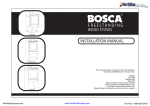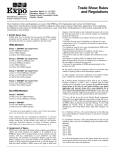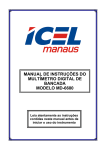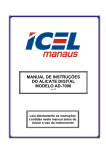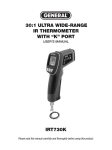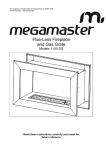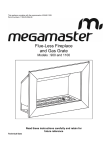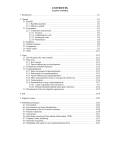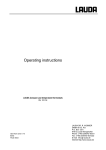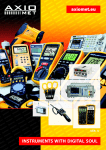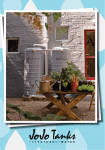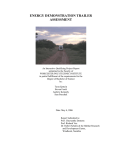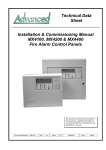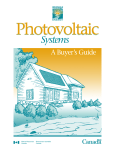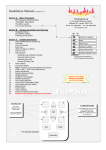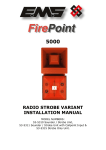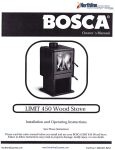Download Bosca Owner Manual
Transcript
N FREESTANDING WOOD STOVES OWNER'S MANUAL This manual includes instructions for the Installation, Operation and Maintenance of your stove. Models Limit 350 / Limit 380/ Limit 450 Aresta 360 / Aresta 400 Firepoint 360 / Firepoint 400 Gold 400 / Gold 800 Classic 400 /Classic 450 Spirit 500 /Spirit 550 Please read this entire manual carefully before installing and lighting your stove. Save these instructions for future use. Always follow the instructions contained in the manual. OWNER'S MANUAL TABLE OF CONTENTS CHIMNEY FIRE 8 What is a chimney fire? 8 What should I do in case of a chimney fire? 8 How can I avoid a chimney fire? 8 TROUBLESHOOTING 9 2 IMPORTANT INFORMATION 9 How can I verify that the installation has been correctly executed? 4 SAFETY PRECAUTIONS 9 OPERATING INSTRUCTIONS 4 How does the double combustion system work? 4 How do I choose appropriate firewood? 5 How can I recognize dry firewood before buying it? 5 How do I check that the firewood is dry before using it? 5 How do I light the stove? 6 How do I reload firewood in the stove? 6 How do I turn off the stove? 6 PRINCIPAL COMPONENTS 1 INTRODUCTION 2 INSTALLATION 2 What is the most adequate location to install my Bosca stove? 2 What is the correct way to install my Bosca stove? MANTENANCE AND CLEANING What maintenance does my Bosca stove require? 6 6 How do I clean the flues on my stove? 7 How do I remove the ash from my stove? 8 How do I clean the glass panel on my stove? 8 OWNER'S MANUAL MAIN COMPONENTS 1 Collar flue gas 2 Glass Ceramic (Resists temperatures up to 1472ºF/800ºC) 3 Ashtray Door 4 Locking System 5 Ashpan 6 Air Inlet through the firebox base (Easy Lighting System) 7 Air Intake 8 Refractive Bricks 9 Removable Baffle 1 10 9 2 8 10 Combustion Control (Primary Air Control) 7 IMPORTANT: THE INSTALLATION AND MAINTENANCE OF THIS STOVE IS COMPLEX AND MUST ONLY BE EXECUTED BY PROFESSIONALS CERTIFIED BY THE MANUFACTURER. 6 AUTHORIZED INSTALLERS ARE PROFESSIONALS WHO HAVE UNDERGONE DEMANDING TRAINING PROGRAMS. 3 4 -1- 5 OWNER'S MANUAL INTRODUCTION 7 20 28 Congratulations on purchasing a Bosca stove. By choosing one of our products you automatically receive the support, guarantee and experience of our more than 20 years manufacturing stoves equipped with double combustion systems that allow for an efficient use of firewood with a minimum impact on the environment. 14 7 20 Bosca products are manufactured using only prime quality materials and the latest in design and technology that, in the hands of our experienced workers, ensures our products meet the highest international standards. Walls without protection (cm) Additionally, our Pre- and After-Sales Services count with a highly qualified technical staff to help you with all you need to install and service your stove. Walls with protection (cm) What is the correct way to install my Bosca stove? 1.- We recommend you to use the Bosca Installation Kit to our stoves or stainless steel flue (AISI 439 in 0.5 mm thickness). INSTALLATION To ensure the safe and proper functioning of your stove, it must be installed according to the instructions included in this manual. We strongly recommend that your stove be installed by an Authorized Technical Service. IMPORTANT The junctures of the main flue are designed so that the upper section fits into the lower one. In the case of a double flue it is reversed; the lower section fits into the upper one. In terms of safety, the flue is the most important component of your stove as it is the exhaust for the gases produced by the combustion of firewood. These gases are extremely corrosive, reach high temperatures and often contain fuel components. Studies have demonstrated that fires related to stove or wood cookstoves usually originate near the flue. We recommend you adhere strictly to the installation instructions detailed in this manual. What is the most adequate location to install my Bosca stove? In the case of a freestanding stove, it is essential to choose an adequate location for its installation. The following are the main considerations you should take into account: MAIN FLUE Diameter 6 inches 1. It is important that the stove be located in an area that allows for an adequate circulation of air currents. This will enable the hot air to reach the different rooms of the house more easily. Additionally, the stove must be located so that it is not an obstacle to the free circulation of people, especially children. 2. Be especially careful if you must install the stove close to walls made of flammable material. The same applies to curtains and carpets. The minimum installation distances are detailed below: -2- DOUBLE FLUE Diameter 10 inches OWNER'S MANUAL IMPORTANT The flues change tone as a result of the temperature generated by the stove and may turn a red-blue color depending on the type of stainless steel used. You can remedy this situation by painting them with Bosca High Temperature Spray. IMPORTANT The cap, funnel and the upper end of the flue are screwed to each other. The funnel is not screwed to the double flue to allow space for thermal dilation. This juncture MUST NOT be screwed together. Cap Screwed Juncture 5. If the slope of the roof is less than 60º, the cap must extend at least 60 cm over the highest point. If the slope is more than 60º and the cap cannot extend over the highest point, the tube of the flue must extend at least 150 cm from the perforation. Funnel Free Juncture for Dilatation Rock wool Double Flue Main Flue 150 cms 60 cms 2. Once the stove is positioned, locate the center of the flue on the ceiling and make a perforation that is 38 cm in diameter and goes through the roof to the exterior. A double flue must be placed in the roof space section to ensure it is not in direct contact with flammable materials. The space between the flue and the double flue must be filled with rock wool. Flammable materials must not be closer than 15 cm from the double flue. 3. As the inside of the flue must be cleaned frequently, it should be positioned as direct and vertical as possible. Using elbows is not recommended, but if necessary, no more than two 135º elbows can be used.To ensure proper draft, the longitude of the flue must be between 4 and 10 meters. 6. When installations are performed in locations that are windy and/or when the flue extends over 1.5 m from the roof, wire stays must be used to hold the flue in place. 135º 7. A ceramic or stone floor protection must be placed under the stove when it is installed on a wood or plastic floor. 135º 8. If any type of handiwork, modifications or repairs have been executed close to the flue or the stove after these have been installed, check that none of the specifications indicated in the user’s manual have been altered. 4.- The double flue must preferably be of galvanized steel or zinc alum and 0.5 mm in thickness. Visible interior flues can be painted with high temperature paints (752º F/ 400ºC). Exterior flues can be painted with opaque enamel. 9. If you smell burning or perceive overheating near your stove, request a technical inspection from an Authorized Technical Service. 10. Check that none of the components of the electrical system of your house are affected by the stove or the flue. -3- OWNER'S MANUAL How can I verify that the installation has been correctly executed? OPERATING INSTRUCTIONS We are aware of how important it is to you to feel confident that your stove has been properly installed. Therefore, if you wish to verify the installation, we recommend you use the following diagram to guide your inspection: How does the double combustion system work? Double combustion stoves have a secondary air inlet that preheats the air at a high temperature. This hot air mixes with the combustion gases burning the volatile material and reducing particulate material. This process is known as post combustion. Cap (Stainless Steel) Funnel Stainless steel Primary Air Inlet 10” Double Flue (Galvanized steel) Covers the full length of the main flue from the roof space to the cap. Mineral wool is placed in the space between the flue and the double flue. Air is preheated Secondary Air Inlet Sheet or Scantling (Galvanized Steel) All flammable materials must be at a distance of at least 15cm from the double flue. Ceiling Plate (Stainless or Galvanized Steel) How do I choose appropriate firewood? 6” Main Flue (Stainless Steel) From the heater to the cap. It is important that you understand that one of the elements that will allow you to obtain the maximum performance from your stove is the purchase of good quality fuel. To maximize the effectiveness of your stove follow the instructions detailed below on how to buy, store and manipulate firewood: Rear Protection (If you want to install the stove close to a wood wall, you can place a sheet of metal or another non-flammable material on the wall leaving a space for ventilation in the back). - Prefer firewood of renewable species (especially Eucalyptus) as it is easy for the producer to dry and originates from sustainable forestry. - A highly relevant variable that determines the quality of the firewood is its humidity content. This must be between 18 and 25%, to ensure an adequate duration and avoid energy loss as a result of water evaporation as this reduces the power of the stove. Additionally, by using firewood with low humidity content, you will avoid the production of creosote (a residue of combustion that is deposited on the flues of your stove), resulting in lower maintenance costs. - Remember to buy firewood that is no longer than 30 cm and approximately 15 cm in diameter. This size firewood fits easily in your stove and the larger logs will not have to be cut to fit. Floor Protection Required if the floor is covered in wood, carpet or plastic. - Having good quality firewood of appropriate humidity content does not only depend on buying it correctly. This is only the starting point. If the manipulation of the wood is not adequate, -4- OWNER'S MANUAL your efforts will have been wasted. This is why it is important that you safeguard the storage conditions. The wood must be stored in an isolated location so that it is not exposed to rain and receives adequate air circulation. Under no circumstance must it be in contact with the ground unless it is paved. 4. Light the fire and close the upper door of the stove. 5. Open the door of the ashtray and keep it this way for approximately 3 minutes or until the splinters are lit. How can I recognize dry firewood before buying it? Paper and splinters light in 1 to 5 minutes. - The logs are lighter. - The bark must be partially detached and have cracks on the ends. - It must not have white or grey spots. - When you bend a small splinter with your fingers, it breaks. Ashtray is open. How do I check that the firewood is dry before using it? Place a log in your stove over a large quantity of cinders and check for the following: Dry Firewood: ignites on more than one side in minutes. Humid Firewood: turns grayish-black and takes time to ignite. Wet Firewood: emits a whistle sound, blackens, does not produce a flame and emits a large quantity of smoke. 6.- Open the upper door and add the load of firewood, placing the lightest logs over the lit splinters. It is very important that spaces are left between the logs as these allow for air circulation and consequently a faster and more vigorous ignition. IMPORTANT Wet firewood is NOT apt for use. Firewood Load How do I light the stove? (Easy Lighting System) IMPORTANT The first time the stove is lit the high temperature paint on it will smoke and emit a resin smell for some hours. Open the windows to ventilate. 7.- Close the door and open the lower one again so as to increase the aeration of the combustion chamber. Leave it open for a period of about 5 minutes or until the firewood is lit. 1. Check that the temperer is in its place, if this is not so locate it in the correct position as indicated on page 7. 2. Place crumpled paper in the middle of the firebox. 3. Place various split logs over the paper and some splinters on top of this, preferably in a vertical position. Set the Primary Air Control on “maximum”. Definite load Full combustion Initial Mound Splinters and paper Ashtray door is closed -5- OWNER'S MANUAL 7.-Finally, close the lower door and adjust the Primary Air Control to “maximum” for 5 minutes or until the flames burn vigorously, and then adjust the control to “intermediate". 8.- Learning to manage the stove to your liking requires some practice, as you must first become familiar with its functioning. Do not expect an immediate reaction of the fire when you slide the Primary Air Control. The flame will not intensify nor extinguish quickly as is the case with liquid or gas fuels. Solid fuels like firewood react slowly. IMPORTANT The best moment to reload the stove is when a good layer of cinders has set itself. If this layer is too thin, the way to reload it is repeating the initial lighting procedure (page 5). How do I turn off the stove? Primary Air Control on “maximum” for 5 minutes, and then adjust to “intermediate”. 1.- As your stove is a safe unit it is not necessary to turn it off. However, if you wish to do so, all you have to do is adjust the Primary Air Control to “minimum”. Remember that solid fuels react slowly, so that this process will take several minutes. IMPORTANT The “minimum” position on the Primary Air Control must only be used to turn off the stove. It must never be used as a way to save firewood, as the effect will be to make the functioning of the stove deficient. IMPORTANT If you follow these instructions you will generate an effective combustion that does not produce smoke nor contamination when your start a fire in your stove, while ensuring its optimum functioning. MAINTENANCE AND CLEANING How do I reload firewood in the stove? 1.- Adjust the Primary Air Control to “maximum” and open the door of the firebox (upper door). 2.- Place the dry firewood splinters on the cinders inside the stove. As is the case when lighting the fire, remember that it is better if the logs are arranged with spaces between them to allow air flow. Finally, close the upper door. 3.- Open the lower door of the stove for about 3 minutes or until all the logs are on fire. Finally, adjust the Primary Air Control to the "intermediate” position. Primary Air Control on "maximum" What maintenance does my Bosca stove require? Cleaning the flues is essential to ensure the proper functioning of your stove. This consists of removing the creosote (a flammable substance that results from the combustion of firewood with a high percentage of humidity and/or when there is insufficient air entering) from the interior of the flue. This accumulation obstructs the flue and affects the proper functioning of your stove, making the lighting process slow and tedious and impeding appropriate combustion. Moreover, the combustion will not be vigorous and there will be insufficient draft and abundant smoke emerging from the door. Firewood load IMPORTANT Under certain conditions creosote can ignite, resulting in extremely high and dangerous temperatures. Primary Air Control on "intermediate" Definite load Full combustion The frequency with which the flues must be cleaned varies according to the percentage of humidity in the firewood you use. The flues must be cleaned at least once a year if the firewood you use is dry. However, if it is green or contains over 25% humidity it must be done every 15 or 20 days. -6- OWNER'S MANUAL We recommend the flues of your stove be cleaned by an Authorized Technical Service. If this is not possible for any reason, you can clean the flues yourself by following the instructions indicated below. The tools you will need are a ladder, a screwdriver and a steel brush. After cleaning the flue, check the state of the seal between the flues and the sheet. If necessary, we recommend you reseal with SikaflexR 11FC or a similar product. 4. It is not necessary to totally remove the baffle from the stove once it is dismounted in order to clean the flues. How do I clean the flues of my stove? Your stove is installed in such a way that the flues can be cleaned without uninstalling the unit. 1. Make sure the stove and the flues are both cold before touching them. We recommend your always protect your hands by using safety gloves. 2. Unscrew the cap and remove it. 5. Slide the ball inside the upper side of the flue all the way down until it appears inside the stove. IMPORTANT Bosca stoves contain a baffle that must be dismounted in order to clean the unit. 3. Remove the anchoring screws to dismount the baffle of your stove. We recommend you carefully read the instructions that correspond to your model and that are included with this manual. 6. Pull the rope inside the stove so that the steel brush moves up the flue. Repeat this operation 6 times. Do not use regular steel wool instead of a steel brush. Keep the door as closed as possible to avoid soot being dispersed outside the stove. Oxigenating Tube Baffle Support Baffle Anchoring Screws LATERAL VIEW -7- OWNER'S MANUAL 7. To locate the baffle in its regular position follow the indications recommended in the instructions to dismount the baffle. CHIMNEY FIRE 3 What is a chimney fire? Soot and residue resulting from the combustion of firewood are deposited on the flue. These are called creosote, which is a fuel. Under certain circumstances, the interior of the flue catches fire producing extremely high temperatures that may reach such a level that the flue turns an incandescent red color. 2 1 Incandescent creosote emanations may appear on the upper extreme of the flue. What should I do in the case of a chimney fire? How do I remove the ash from my stove? - Stay calm. A properly installed flue in which the correct materials have been used should resist the situation without problems. The firebox of your stove has a slotted base so that the ashes produced by the combustion of the firewood will be deposited in the ashtray. Check that your stove is cold and proceed to empty the ashtray in a metal container, preferably with a layer of sand on the bottom of it. - Close the door of the stove well and close the Primary Air Control. The fire on the inside of the flue will most probably go out in five minutes. Do NOT open the door of the firebox nor of the ashtray until 30 minutes after the chimney fire is extinguished. Otherwise, the fire could reignite. Take the ashes outside the house to a safe location. Remember that live coals can remain lit for up to 36 hours. The ash of untreated wood makes an excellent fertilizer for your garden. - Keep an eye on the flue, especially in the area of the roof space. - Remove any fuel that may be near the flue. IMPORTANT Always maintain a bed of ash on the inside of the firebox as this will make the accumulation of live coal and reloading easier. - If the situation prolongs excessively or if you suspect the installation was not properly executed, call the fire department immediately. - Do not use your stove again until it has been checked by a certified technician. How do I clean the glass on my stove? One of the appeals of your Bosca stove is the visible fire. However, often this is limited because of spots that appear on the glass of the stove. To avoid this follow the instructions below: How can I avoid a chimney fire? - The key to avoiding a chimney fire is to keep your stove’s gas exhaust system clean. - To keep the flue clean, your stove must function with a vigorous fire. Avoid using your stove with flameless smoking fire. - Use dry firewood. Humid firewood reduces the temperature of the fire and increases the possibility of a chimney fire. - When reloading your stove, avoid cooling the existing fire. Place the Primary Air Control on “maximum” and try that the new logs heat fast. Only after this has occurred should you adjust the Primary Air Control to the “intermediate” position. -The main cause of spots on the glass is directly associated to the use of firewood with high humidity content together with maintaining the Primary Air Control on “minimum”. Avoid the occurrence of both by buying dry firewood and storing it correctly and maintaining the Primary Air Control in the "intermediate" position. -Periodically clean the glass of your stove with Bosca Glass Cleaning Cream. -8- OWNER'S MANUAL SAFETY PRECAUTIONS TROUBLESHOOTING Smoke is coming out of my stove The glass is dirty The stoves are designed to only use firewood as fuel. The use of any other kind of fuel could damage the stove and make the warranty null and void. · Check the installation. The cap of the flue must have sufficient space to evacuate smoke and extend 60 cm over the roof of the house. · Reload the stove properly. · Keep the flue of your stove clean. · Check the temperer is correctly installed. · Use firewood with a low percentage of humidity. · Keep the Primary Air Control in the "intermediate" or "maximum" position. · Check that the gasket door sealing (grey ring) is in good conditions. · Remove dirt with Bosca Window Cleaner. Stained flues · Use firewood with a low percentage of humidity. · Do not overload your stove to avoid overheating. Stove doesn’t heat · Use firewood with a low percentage of humidity. · Reload your stove over a good bed of live coals. · Keep the Primary Air Control in the "intermediate" or "maximum" position. The door of your stove’s firebox must remain closed while the fire is on. The stoves must be properly installed to avoid possible fires. The installation instructions contained in this manual must be strictly adhered to. Prefer an Authorized Installation Service. Periodically inspect the flues and clean if necessary. The accumulation of creosote can provoke fires inside the flues. gas Visible smoke · Use firewood with a low percentage of humidity. · It is normal to have smoke emissions the first few minutes of ignition, the smoke will ease when the combustion chamber reaches a higher temperature. (this should not take more than 30 minutes) Baffle is worn out · If your stove has been in use for more than three years (useful life of the baffle), replace it. gas Keep any flammable materials away from your stove (furniture, curtains, papers, plastic, etc.). Do not leave clothes or other flammable materials on your stove. IMPORTANT INFORMATION Your Bosca stove is identified by a serial number stamped on a plate on the back of the unit. No other Bosca stove of similar model has the same serial number, which may be requested if you require a service. (Fill in the information of your stove) Model: Purchase Date: Do not burn large amounts of paper or other flammable materials that may produce a fast and extremely hot fire. Serial Number: Distributor: -9- Never use gasoline, paraffin or other flammable fuels to light the fire. Do not store gasoline or other flammable fuels near the stove. Do not make modifications to the installation of the stove without consulting specialized technicians. If elements close or in contact with stove begin to smoke it is overheating. Do not add more wood, make sure the firebox is well closed and turn off the Air Control completely. Direct contact with a lit stove can produce serious burns in children and adults. LIBRE POSICION Mega Group (Distributor of BOSCA) Addresses: No. 8, Donkerhoek, Pretoria, 0002, South Africa Telephone: (+27) 086 123 6342 Fax: (+27) 012 802-1516 Postal Addess; PO Box 15, Woodlands, 0072 E-Mail: [email protected] Web: www.bosca.co.za Made in Chile













